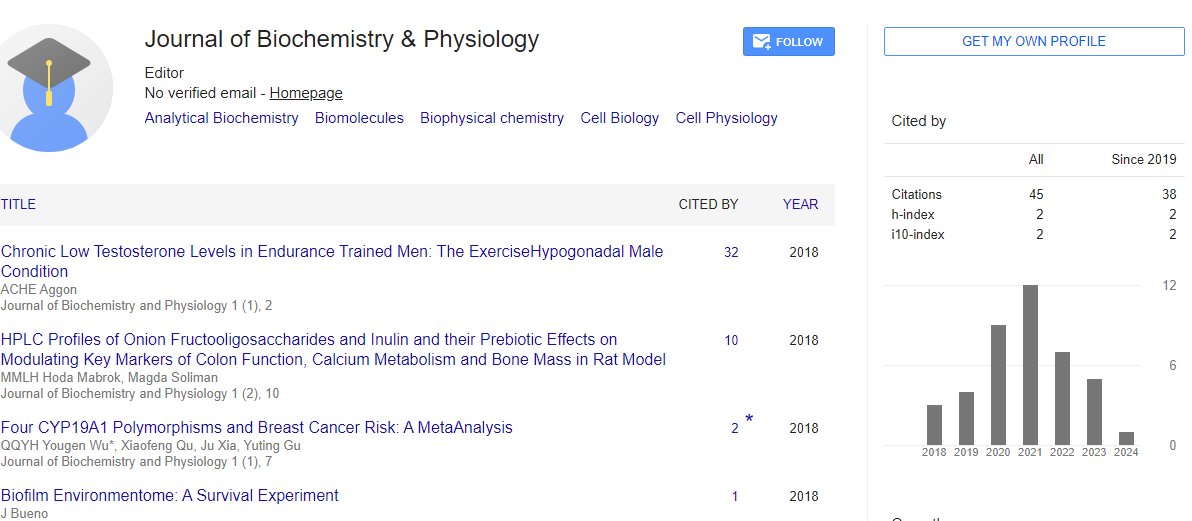Commentary, J Biochem Physiol Vol: 7 Issue: 2
Mass Spectrometric Analysis of Post-Translational Modifications in Human Proteins
Akbari Jisi Fu*
1Department of Genome and Proteomics Centre, University of Victoria, Victoria, British Columbia, Canada
*Corresponding Author: Akbari Jisi Fu,
Department of Genome and Proteomics
Centre, University of Victoria, Victoria, British Columbia, Canada
E-mail: Fusijak@ca
Received date: 28 May, 2024, Manuscript No. JBPY-24-137798;
Editor assigned date: 30 May, 2024, PreQC No. JBPY-24-137798 (PQ);
Reviewed date: 13 June, 2024, QC No. JBPY-24-137798;
Revised date: 21 June, 2024, Manuscript No. JBPY-24-137798 (R);
Published date: 28 June, 2024, DOI: 10.4172/jbpy.1000156.
Citation: Fu AJ (2024) Mass Spectrometric Analysis of Post-Translational Modifications in Human Proteins. J Biochem Physiol 7:2.
Description
Post-Translational Modifications (PTMs) of proteins are important for the regulation of cellular functions, affecting protein activity, localization, interaction, and stability. PTMs such as phosphorylation, glycosylation, ubiquitination, acetylation, and methylation can significantly alter protein function and are involved in various biological processes and diseases, including cancer, neurodegeneration, and cardiovascular diseases. Mass Spectrometry (MS) has emerged as a powerful analytical tool for the comprehensive study of PTMs due to its sensitivity, accuracy, and ability to analyze complex protein mixtures. Mass spectrometry enables the identification and quantification of PTMs by analyzing the mass-to-charge ratio of ionized molecules. The high sensitivity and specificity of MS make it possible to detect low-abundance PTMs, which are often challenging to analyze using traditional biochemical methods. MS-based proteomics involves several steps, including protein extraction, digestion, peptide separation, MS analysis, and data interpretation.
The first step in MS analysis is the extraction of proteins from biological samples. This is typically followed by the digestion of proteins into peptides using proteolytic enzymes, such as trypsin. Trypsin cleaves proteins at the carboxyl side of lysine and arginine residues, generating peptides suitable for MS analysis. In some cases, additional enzymatic or chemical treatments are used to enrich specific PTMs. For example, phosphopeptides can be enriched using Immobilized Metal Affinity Chromatography (IMAC) or Titanium Dioxide (TiO2) beads. Prior to MS analysis, peptides are often separated using Liquid Chromatography (LC), typically Reversed- Phase High-Performance Liquid Chromatography (RP-HPLC). LC separates peptides based on their hydrophobicity, enhancing the detection of low-abundance peptides and reducing sample complexity. This separation step is crucial for improving the resolution and sensitivity of MS analysis.
Mass spectrometric analysis
The core of PTM analysis involves the use of MS to detect and characterize peptides. Two common types of mass spectrometers used in PTM analysis are Matrix-Assisted Laser Desorption/Ionization (MALDI) and Electrospray Ionization (ESI). Both techniques ionize peptides, but they differ in their ionization mechanisms and applications. MALDI is often used for the analysis of large biomolecules and complex mixtures, while ESI is preferred for coupling with LC and for the analysis of smaller peptides and proteins. In MS, ionized peptides are separated based on their mass-to-charge ratio (m/z) in a mass analyzer, such as a quadrupole, Time-Of-Flight (TOF), or orbitrap. The resulting mass spectra provide information about the peptide masses, which can be used to infer the presence of PTMs. Tandem Mass Spectrometry (MS/MS) is particularly useful for PTM analysis, as it involves the fragmentation of peptides into smaller ions, allowing for the determination of the exact location of the PTM on the peptide.
The final step in MS-based PTM analysis is the interpretation of the mass spectra. Specialized software tools, such as Mascot, SEQUEST, and MaxQuant, are used to match the observed peptide masses to theoretical masses in protein databases, identifying the peptides and their corresponding PTMs. These software tools consider various PTMs during the database search, enabling the identification of modified peptides. Quantitative analysis of PTMs can be performed using label-free methods or stable isotope labeling techniques, such as SILAC (Stable Isotope Labeling by Amino acids in Cell culture) or iTRAQ (Isobaric Tags for Relative and Absolute Quantitation). These techniques allow for the comparison of PTM levels between different samples, providing insights into the dynamic regulation of PTMs under different biological conditions.
Applications of MS in PTM research
MS-based analysis of PTMs has broad applications in biological and biomedical research. For instance, the study of phosphorylation events is critical for understanding signal transduction pathways. Aberrant phosphorylation is a hallmark of many cancers, and MSbased phosphorproteomics has been instrumental in identifying dysregulated kinases and phosphatases as potential therapeutic targets. Glycosylation, another common PTM, plays a vital role in protein folding, stability, and cell-cell communication.
MS analysis of glycoproteins has provided valuable insights into the glycosylation patterns associated with diseases such as diabetes and congenital disorders of glycosylation. Despite its powerful capabilities, MS-based PTM analysis faces several challenges. The low stoichiometry of many PTMs, the complexity of biological samples, and the need for extensive sample preparation can limit the sensitivity and throughput of MS analysis. Additionally, the interpretation of MS data requires advanced bioinformatics tools and expertise.
Conclusion
Mass spectrometry has revolutionized the study of posttranslational modifications, providing detailed insights into protein regulation and function. The ongoing development of MS technologies and analytical methods promises to further advance our understanding of PTMs and their implications in health and disease, surface the way for novel therapeutic strategies and biomarkers.
 Spanish
Spanish  Chinese
Chinese  Russian
Russian  German
German  French
French  Japanese
Japanese  Portuguese
Portuguese  Hindi
Hindi 